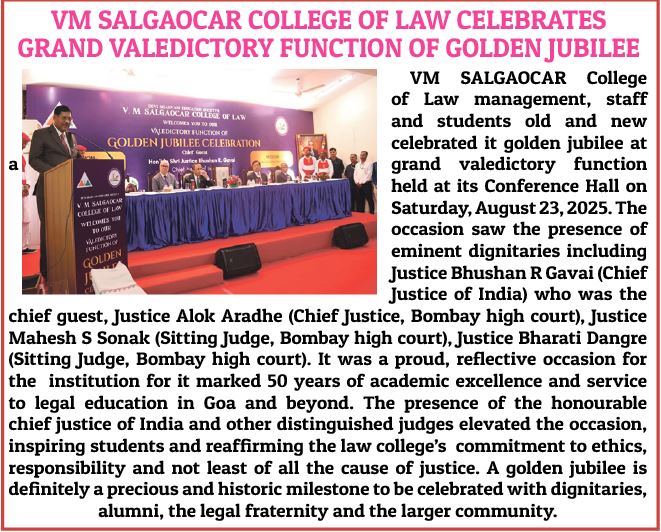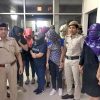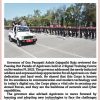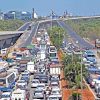Goa is abuzz with excitement as vintage bike and car owners, users, collectors and fans are decking […]

LETTER TO THE EDITOR FOR ISSUE DATED AUGUST 30,2025
Aug 30-Sept 05, 2025, Letters To The Editor August 29, 2025“PRIMARY LAW” TEXTBOOKS INTRODUCED IN SCHOOLS
FORMAL “primary law textbooks” should be typically used in primary or secondary schools, for general knowledge. Some school systems and educational advocates argue that basic legal concepts should be incorporated into the curriculum to promote civic literacy and human rights education.
This is often done through other subjects rather than as a standalone law course. But law should be at center of such an educational subject. Primary law textbooks must be introduced and taught to students so that they become familiar with basic legal ideas and laws past and present. So much has changed in recent times which we don’t know anything about or have just a vague idea!
In the US, these classes offer students courses covering the country’s Constitution, the Bill of Rights, and the different court systems, which are foundational to American law. Similarly, Indian curricula should touch upon the basic features of India’s Constitution in simple methods.
Social studies and history subjects address landmark judicial decisions and historical events that shaped legal precedent, providing context for the development of law.
Some countries and school systems offer dedicated “Legal Studies” or similar courses at the senior secondary level. For example, India has a Legal Studies curriculum that covers topics like the constitution, jurisprudence, and civil and criminal courts.
But the ABC of the law should be taught in school level like civil science, to know IPC or CrPC Acts regarding robbery, cheating, molestation, forgery etc, also Agriculture Tenancy and Mundkar, Acts, RTI and Education Act, Anti-labour Childrens Act, etc. Law awareness among students is very important as per the time and therefore primary law textbooks should be introduced in our educational system.
—Rajesh Banaulikar, Goa.

CLOSE CALL AT MOPA AIRPORT
ON December 5, 2024 an Air India flight from the Mopa airport, with 158 people flying to Hyderabad, missed a near-disaster. The final report recently released by the Aircraft Accident Investigation Bureau (AAIB) found that the aircraft had lined up on a parallel taxiway instead of Runway 28.
When the aircraft reached 124 knots (~130 km/hr), the Air Traffic Control (ATC) spotted the blunder and ordered an immediate abort. As per the AAIB, the First Officer was distracted by logging into the Electronic Flight Bag and the captain failed to cross-check the runway lights and signages. AAIB also remarked that Mopa lacks an Advanced Surface Movement Guidance and Control System (A-SMGCS), the ATC granted clearance while the aircraft was still on taxiway and limited visibility due to topography, as the other reasons.
Cockpit crew and ATC personnel work in high-stress environments where the adrenalin flow peaks. They are trained to be in control, concentrate and be cool and calm under duress, but sometimes matters may go out of hand. One can understand human error that could happen because of several reasons, but not having the essential facilities, either in the aircrafts, ATC tower and at the airport are deeply concerning.
The Mopa airport commenced its operation on Jan 5, 2023 and caters to domestic and international services. It is shocking that it does not yet have the A-SMGCS. Now the AAIB has asked the Airport Authority of India (AAI) to urgently install it. How did the AAI grant approval to start services without the A-SMGCS? This may be one system that was not ticked from the checklist but we do not know which other valuable tools are missing from the Mopa airport and need to be fixed in the coming days.
In a hurry to permit operations at the earliest for the operators (airports, airlines, stakeholders) to start raking in the profits, the approving authorities are putting lives and infrastructure at risk.
—Sridhar D Iyer, Caranzalem, Goa
ED RAID ON AAP LEADER BASELESS
WE at the Aam Aadmi Party (AAP) would like to state that we strongly oppose the BJP-led Central government stating that the Enforcement Directorate’s (ED) raid on AAP leader Saurabh Bharadwaj’s residence in Delhi was a deliberate attempt to distract the public from the controversy surrounding Prime Ministrer Narendra Modi’s educational degrees.
The issue reignited after the Delhi High Court on Aug 25, 2025 quashed the Central Information Commission’s (CLC) 2016 order that had allowed an RTI activist to inspect Delhi University’s 1978 B.A. records, the year PM Modi claims to have graduated.
For AAP, ED raids are nothing new. Houses of several AAP leaders have been raided in the past, yet not a single rupee was found. This raid at Bharadwaj’s home will also yield nothing. The BJP claims he committed a scam in hospital construction but the dates do not match. Saurabh Bharadwaj was not even the health minister during that period. He took charge two years later.
The raids are a fabricated strategy. The BJP government was silent for two years. Suddenly after the HC order, they bring up the issue. Why now? Clearly, to divert attention from Modi’s fake degree.
When alumni achieve great heights, universities usually celebrate them. But in this case, Delhi University is hiding the prime minister’s degrees for nine years. This only proves that the degrees are fake.
AAP was the first to raise this issue in 2016, and since then, BJP has been running away from the truth. India has had leaders with little formal education before, but this is the first time we have a prime minister who is lying to the nation.
— Valmiki Naik, working president, AAP, Goa
















